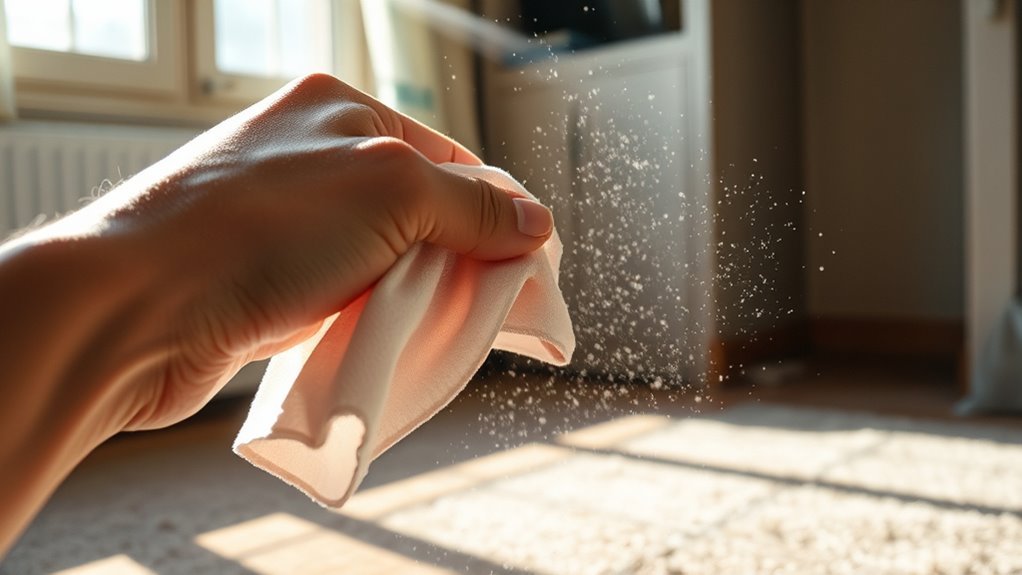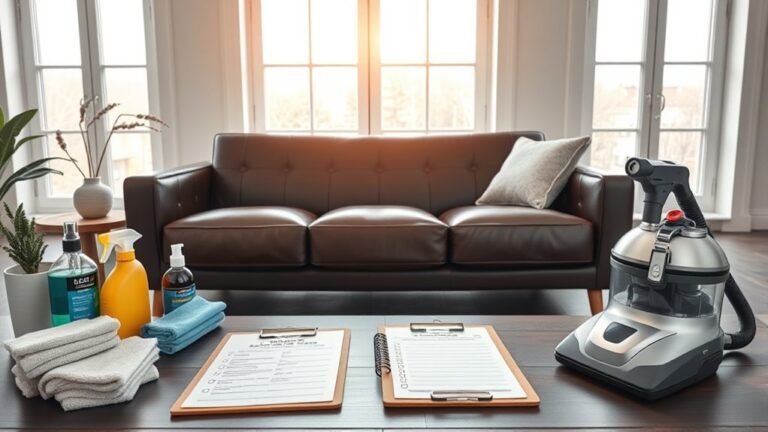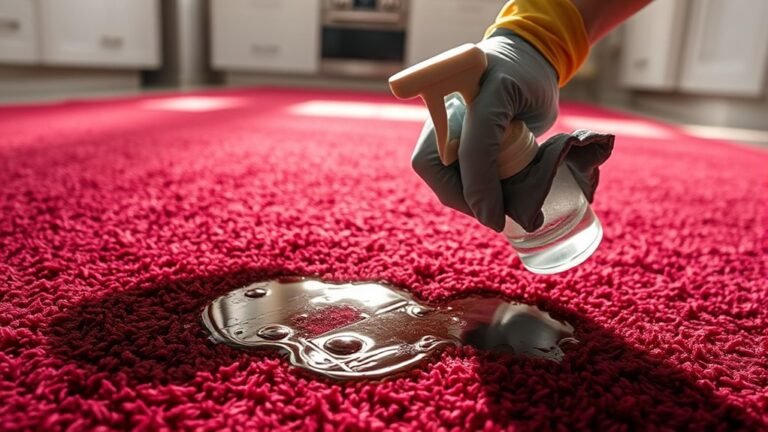Common Mistakes When Cleaning Dust
When cleaning dust, don’t use dry cloths or feather dusters—they just scatter particles, making things worse. Always dust before vacuuming, starting from higher to lower surfaces, and don’t neglect ceiling fans, top shelves, or electronics. Use slightly damp microfiber cloths with compatible cleaners to trap dust effectively, and clean your dusting tools regularly. Skipping routine dusting only compounds the problem and risks allergies. To master dusting for a truly cleaner home, keep these key details in mind.
Using Dry Cloths That Just Spread Dust

Why do dry cloths often do more harm than good when dusting? Because they tend to scatter dust particles into the air rather than capturing them, leaving surfaces less clean and the environment dustier. If you want to break free from this ineffective habit, consider dry cloth alternatives like microfiber cloths slightly dampened with water or specialized dusting sprays. These options trap dust instead of pushing it around. Effective dusting techniques involve gentle, systematic motions that lift dust away without redistributing it. By choosing the right tools and methods, you maintain cleaner spaces and breathe easier. Don’t settle for dust spreading—embrace precision. This way, you reclaim control over your environment, making your cleaning efforts truly efficient and freeing you from repetitive, futile dusting cycles.
Ignoring High and Hard-to-Reach Areas
You might be missing dust buildup on ceiling fans and the tops of shelves because these spots are easy to overlook. Ignoring these areas can lead to poor air quality and a less polished look in your space. Make it a habit to include hard-to-reach surfaces in your regular cleaning routine.
Overlooking Ceiling Fans
Although ceiling fans are often out of sight, they shouldn’t be out of mind during your cleaning routine. Dust accumulation on fan blades can quickly degrade air quality and reduce efficiency, so regular ceiling fan maintenance is essential. Don’t wait until the dust is visibly thick; a quick wipe every few weeks prevents buildup. Use a microfiber cloth or a specialized duster to capture dust without scattering it. Safely reach the fan by using a sturdy ladder or step stool, ensuring you maintain balance and control. Overlooking this high, hard-to-reach area compromises your freedom to breathe clean air and enjoy a fresh space. Incorporate ceiling fan cleaning into your routine for a healthier, dust-free environment that truly supports your lifestyle.
Neglecting Top Shelves
Since top shelves are often out of immediate sight, they easily become neglected during cleaning sessions. Ignoring these areas can lead to dust buildup, affecting air quality and overall cleanliness. You can reclaim control by prioritizing top shelf organization and using targeted cleaning techniques. A sturdy step ladder and microfiber cloth will be your best allies. Here’s a quick reference to refine your routine:
| Task | Tip |
|---|---|
| Dust Removal | Use a microfiber duster |
| Reach | Employ a stable step ladder |
| Frequency | Clean monthly |
| Organization | Store seldom-used items |
| Safety | Avoid overreaching |
Overlooking Electronic Devices and Screens

One often overlooked area during cleaning is your electronic devices and screens, yet neglecting them can lead to grime buildup and reduced functionality. You might be tempted to skip these delicate surfaces, but maintaining device cleanliness is crucial to preserve clarity and responsiveness. Use a microfiber cloth slightly dampened with distilled water or a specialized cleaner designed for electronic screens—never spray liquids directly. Gently wipe in a circular motion to remove dust, fingerprints, and oils without scratching. Regular attention prevents dust accumulation that can interfere with sensors and cooling vents. By prioritizing your devices during cleaning, you guarantee they remain efficient, extend their lifespan, and keep your digital environment crisp and free from distracting smudges. Don’t let overlooked screens compromise your freedom to work or relax with ease.
Dusting Before Vacuuming or Sweeping
After giving your electronic devices the attention they deserve, it’s important to tackle dust on surfaces before you vacuum or sweep. Following the correct cleaning order prevents dust from settling back onto freshly cleaned floors. Start with effective dusting techniques—use microfiber cloths or electrostatic dusters to capture dust rather than scatter it. Work from higher surfaces to lower ones, ensuring dust falls downward and gets collected later. Skipping this step or reversing the order means you’ll be chasing dust twice, wasting effort and time. By mastering this precise sequence, you maintain a cleaner environment with less effort, gaining the freedom to focus on what matters most. Remember, thoughtful dusting before vacuuming or sweeping isn’t just smart—it’s essential for thorough cleanliness.
Using the Wrong Cleaning Products

Choosing the wrong cleaning products can quickly undo your hard work and even damage surfaces. You need to verify the cleaning agents you pick align with the surface material and dust type. Lack of product compatibility can lead to stains, discoloration, or residue buildup, limiting your freedom to maintain a pristine space.
| Cleaning Surface | Recommended Cleaning Agents |
|---|---|
| Wood | Mild soap, water, wood polish |
| Glass | Alcohol-based cleaners |
| Electronics | Specialized electronic wipes |
Avoid harsh chemicals on delicate surfaces—they’re not worth the risk. Always check labels for product compatibility and test in an inconspicuous area first. This precision protects your belongings and maximizes cleaning efficiency. Choose wisely, and you’ll enjoy dust-free freedom without unintended damage.
Neglecting Air Filters and Vents
While selecting the right cleaning products is important, overlooking air filters and vents can undermine your efforts by allowing dust and allergens to recirculate constantly. Proper filter maintenance and vent cleaning are essential to achieving a truly clean environment. Neglecting these components means you’re only addressing surface dust, while hidden particles continue to compromise air quality. You should:
Ignoring air filters and vents lets dust recirculate, undermining your cleaning efforts and air quality.
- Replace or clean air filters regularly to prevent buildup and maintain airflow efficiency.
- Schedule thorough vent cleaning to remove accumulated dust and debris inside ductwork.
- Inspect HVAC systems periodically to verify filters fit properly and vents aren’t blocked.
Relying Solely on Feather Dusters
You might think feather dusters are enough for dusting, but they often just spread dust around instead of removing it. This can leave surfaces looking cleaner while particles settle elsewhere, causing buildup over time. To truly clean, you’ll need more effective tools like microfiber cloths or vacuum attachments designed to trap dust.
Ineffective Dust Removal
Although feather dusters might seem convenient, relying on them alone often leaves behind fine dust particles and allergens. You need to recognize that ineffective techniques only spread dust rather than remove it. To truly free your space from dust, you must use proper tools designed for thorough cleaning.
Consider these points:
- Feather dusters miss microscopic dust; microfiber cloths trap particles more effectively.
- Without dampening surfaces, dust clings stubbornly, making removal incomplete.
- Vacuum cleaners with HEPA filters capture allergens that feather dusters simply displace.
Dust Redistribution Issues
Because feather dusters lack the ability to trap dust, they often just shift particles from one surface to another. When you rely solely on them, dust particle movement becomes a significant issue, dispersing fine particles into the air and settling on nearby areas. This redistribution not only undermines your cleaning efforts but also compromises air quality and can trigger allergies. Without effective dust containment, you’re fundamentally spreading the problem instead of solving it. To maintain a truly clean environment, it’s vital to understand that dust removal isn’t just about surface appearance; it’s about capturing and containing dust particles. Recognizing the limitations of feather dusters empowers you to avoid common pitfalls and achieve a cleaner, freer space that stays fresh longer.
Suitable Alternatives Needed
While feather dusters might seem convenient, relying solely on them can leave your space inadequately cleaned. They often just shift dust around instead of trapping it, which means particles resettle quickly. To truly free your environment from dust, you need suitable cleaning products and effective dusting techniques.
Consider these alternatives to improve your routine:
- Use microfiber cloths that attract and hold dust without scattering it.
- Opt for electrostatic dusters designed to capture dust rather than disperse it.
- Employ vacuum attachments with brush heads to remove dust from hard-to-reach places efficiently.
Not Cleaning Dusting Tools Regularly
A common oversight in cleaning routines is neglecting to clean your dusting tools regularly. When you skip proper tool maintenance, dust and allergens build up on your dusters and cloths, spreading particles instead of removing them. To maintain freedom from allergens and guarantee effective dust removal, set a cleaning frequency for your tools—ideally after every few uses or at least weekly. Rinse microfiber cloths or wash feather dusters according to their care instructions to maintain their dust-trapping abilities. Ignoring this step compromises your efforts, making dusting less efficient and potentially reintroducing dirt to surfaces. By prioritizing regular tool maintenance, you’ll preserve your tools’ lifespan and keep your environment truly dust-free without extra hassle.
Skipping Routine Dusting Sessions
If you skip regular dusting sessions, dust and allergens build up quickly on surfaces. This accumulation doesn’t just make your home look unclean—it also worsens indoor air quality. Staying consistent with dusting helps maintain both a healthier environment and a polished appearance.
Neglecting Regular Schedule
Even though dust might seem harmless at first, neglecting a regular cleaning schedule quickly allows it to accumulate, worsening indoor air quality and triggering allergies. You need to set a consistent dusting frequency to maintain a healthy environment and avoid overwhelming buildup. Without cleaning reminders, it’s easy to fall behind and let dust settle unnoticed. To keep on track, consider these strategies:
- Establish specific days for dusting to build a routine.
- Use digital or physical reminders to prompt timely cleaning.
- Break tasks into manageable sections to prevent burnout.
Accumulation Risks Increase
When you skip routine dusting sessions, dust and allergens accumulate rapidly, creating a more challenging cleaning task later on. This buildup doesn’t just make your space look neglected—it heightens health risks, especially if you or others suffer from a dust allergy. Over time, layers of dust trap pet dander, pollen, and other irritants, increasing exposure and triggering symptoms. Ignoring these small but regular cleaning steps means you’ll face stubborn dirt that’s harder to remove and might require stronger chemicals or more effort, limiting your freedom to enjoy a clean, comfortable home effortlessly. Staying consistent with dusting prevents this accumulation, reducing health risks and allowing you to breathe easier without the burden of overwhelming cleaning tasks piling up. Prioritize routine dusting to safeguard your health and maintain your space with ease.
Impact on Air Quality
The air quality in your home can deteriorate quickly without regular dusting. When you skip routine dusting sessions, airborne particles accumulate, turning your living space into a reservoir of indoor pollutants. These particles include dead skin cells, pet dander, pollen, and dust mites—all of which worsen respiratory issues and allergies.
Neglecting dusting leads to:
- Increased concentration of allergens that trigger asthma and sensitivity
- Circulation of fine particles that settle in your lungs when inhaled
- Growth of mold spores in dust-laden environments, further compromising air purity
Wearing Shoes Indoors While Dusting
Two key reasons make wearing shoes indoors while dusting a common cleaning mistake: it spreads dirt and reduces your control. When you keep shoes indoors, you track in unseen particles that settle on surfaces, undermining your dusting efforts. This contradicts basic dusting etiquette, which prioritizes cleanliness and efficiency. Plus, shoes add unnecessary bulk, limiting your ability to maneuver close to surfaces or under furniture where dust accumulates. By removing your shoes, you not only protect your floors but also gain better balance and precision, allowing you to dust more thoroughly. Embracing this simple habit enhances your freedom to clean effectively, ensuring that dust is removed rather than redistributed. Remember, true dusting etiquette is about smart choices that save time and deliver lasting results.
Frequently Asked Questions
How Often Should I Replace My Air Filters for Effective Dust Control?
You should replace your air filters every 3 months to maintain ideal air quality and guarantee effective dust control. However, if you live in a dusty environment or have pets, consider changing them more frequently—every 1 to 2 months. Regular filter maintenance is key to preventing dust buildup and keeping your space fresh. Staying on top of this gives you the freedom to enjoy cleaner air without constant worry about allergens or dust accumulation.
Can Indoor Plants Help Reduce Dust Accumulation?
Yes, indoor plants can help reduce dust accumulation to some extent. Their leaves trap dust particles, aiding in dust absorption and improving air quality. While they’re not a replacement for regular cleaning, having a few well-chosen indoor plants can support your efforts in keeping dust levels down. Just make sure to dust the plants themselves regularly, or they might become dust collectors instead of dust absorbers.
What Is the Best Time of Day to Dust My Home?
You’ll find the best time of day to dust your home is during daylight hours when natural light is strongest. This ideal lighting helps you spot dust particles more easily, ensuring thorough cleaning. For best cleaning practices, tackle dust in the morning or early afternoon when air circulation is better, reducing dust settling. This approach lets you maintain a fresher, freer living space with less effort and better results.
Are There Any Health Risks Associated With Household Dust?
Dust in your home can be like a silent storm, stirring up dust allergies and causing respiratory issues if left unchecked. You might not see it, but microscopic particles can trigger sneezing, wheezing, or worsen asthma symptoms. Taking control by cleaning regularly helps you breathe freely and reduces health risks. Being proactive guarantees your space feels safe, letting you enjoy your freedom without the burden of hidden irritants lurking in the air.
How Can I Prevent Dust Buildup on Upholstery and Curtains?
To prevent dust buildup on your upholstery and curtains, establish a regular upholstery cleaning routine using a vacuum with a brush attachment to gently lift dust without damaging fabric. For curtain maintenance, frequently shake them out and wash or steam clean according to care labels. Keep windows closed when pollen or dust levels are high, and use air purifiers to reduce airborne particles. These steps help you maintain fresh, dust-free textiles effortlessly.






